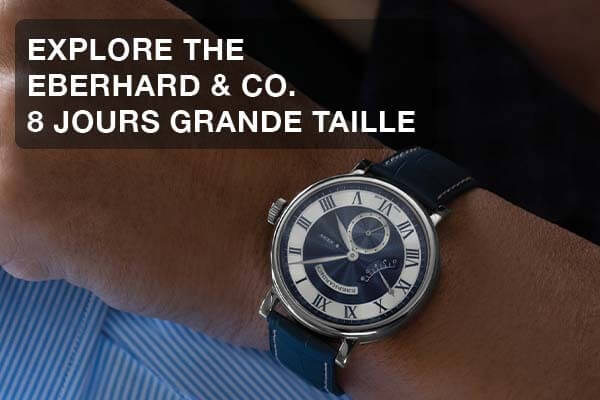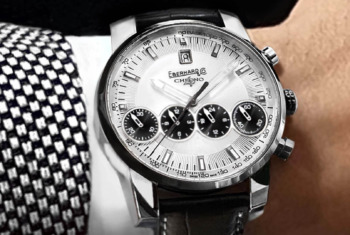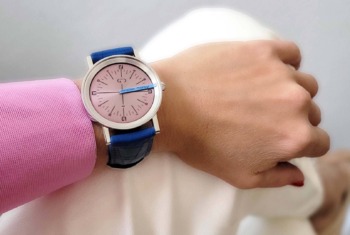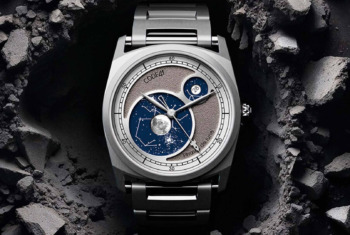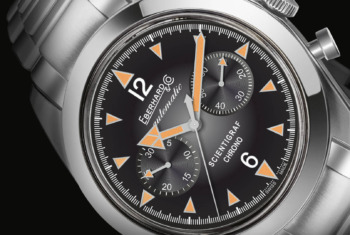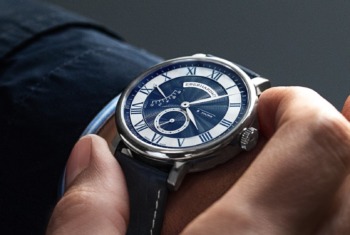
THE BEST OF GLASHÜTTE
Granted, the Swiss built some of the best watches in the world. However, the German watchmakers should not be overlooked, particularly those from the city of Glashütte, Saxony. Amongst connoisseurs the fine watches from the region are regarded as the ultimate ticking benchmark. Situated between Dresden and the border to Czech Republic, Glashütte has long established its status as the “Mecca of German Watchmaking”. Join us, as we take you through a journey in Glashütte to visit 5 of the best watch manufacturers from the city, as well as introducing some of their best horological creations.
5. Brave the Elements: Nautische Instrumente Mühle Glashütte
The manufacture of Mühle Glashütte was originally founded by Robert Mühle in 1869. The Company is currently run by the fifth generation of the family, under the leadership of Thilo Mühle. On the high seas or in the water, the nautical watches from Mühle Glashütte are totally in their elements. For 20 years, the Manufacture has been building instrument-like watches. In order to create timepieces that would meet the most extreme requirements, Mühle Glashütte often collaborates with Special Forces in the conception of their new creation.
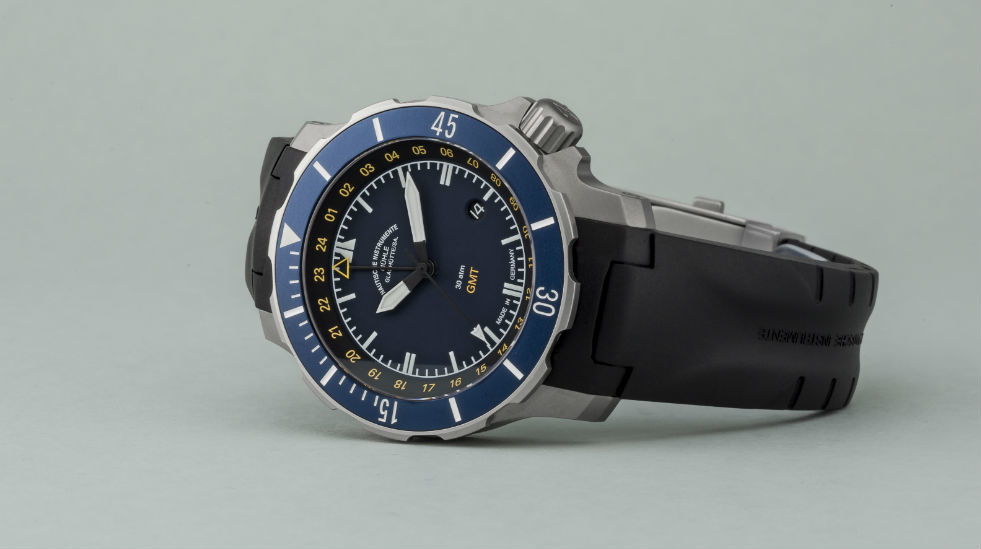
The All-rounder: Seebataillon GMT
Introduced in 2015, the Seebatallion GMT, is the result from one of such collaborations mentioned above. This watch is designed for the Seebataillon of the German Navy, whose soldiers protect the ships and crews of the navy on the high seas, in the port, as well as on foreign missions. Mühle’s Seebataillon GMT was developed with the display of a second time zone. In the development of this robust and sporty model, the focus was on the excellent readability of the dial from every angle. The 44mm titanium case houses a Swiss automatic movement, which has been optimized with the specially developed rotor control developed by Mühle and its own rotor. Both components are visible through the transparent bottom of the case. The dial is protected by a massive, 2.5 mm thick sapphire glass.
4. For the Love of Details: Moritz Grossmann

When one recounts the history of watchmaking in Glashütte, the name of Carl Moritz Grossmann (1826 – 1885) ought not to be forgotten. Grossmann’s name is often mentioned with Ferdinand Adolph Lange (the Founder of A. Lange & Söhne). 9 years after setting up his own watch manufacture at Glashütte, F.A. Lange took his long-time friend, Moritz Grossmann, into the Ore Mountains (Erzgebirge) and encouraged him to open up his own workshop. With a team of specialists, Grossmann soon began to create precision instruments, fine pocket watches, pendulum clocks, and sea chronometers. In 1878, Grossmann also co-founded the German Watchmaking School (die Deutsche Uhrmacherschule), where he remained as an instructor until his passing in 1885.
Over the years, Grossmann’s reputation as a genius watchmaker may have faded. It wasn’t until the founding of the Grossmann Uhren GmbH in 2008, Christine Hutter, a trained watchmaker herself, breathed a new life to the name of Moritz Grossmann. Under Hutter’s supervision, some of the finest Saxon timepieces have since re-emerged. The watches from the modern-day Moritz Grossmann are inspired by the Watchmaker’s philosophy on precision and aesthetics. The brand is known for its penchant for watch hands and the watchmakers at Moritz Grossmann go into great lengths in creating them. Moritz Grossmann’s signature watch hands are characterised by their three-dimensionality and a finely spiked tip. Forgoing the classic shade of blue, the watchmakers annealed the hands of the watch to achieve the distinctive shade of violet and brown.
What also captures our attention is of course the construction of the watches’ calibres, which is based on a 2/3 German Silver plate. Their elaborate decorations – various polishes and cuts as well as the Glashütte stripe finish – bear the signature of Moritz Grossmann himself. The creative combination of the various precious metals such as gold, nickel silver and steel creates a colourful work of art, which makes the Grossmannian brown-violet screws stand out even more.
Impeccable Craftsmanship: Benu

Grossmann’s first watch of the modern era is Benu. This term comes from the ancient Egyptian mythology: the divine Heron called “Benu” flies to his nest in the evening and burns there. He leaves behind an egg, from which a new Benu arises the next morning. The profoundly elegant watch carries Moritz Grossmann’s credo of watchmaking into the 21st century: straightforward designs, innovative and well thought through mechanics, all impeccably executed in traditional expert craftsmanship. The Benu 41 power reserve has the same restrained elegance and classic appearance and it comes with a linear power reserve indicator on the dial, just below the brand logo. A glance through the sapphire glass reveals the intricate technical complications that define the hand wound caliber 102.0, which is precision adjusted in five positions. These horological accomplishments are typical for the House of Moritz Grossmann. The tiered balance bridge with Grossmann’s regulating screw, the superimposed chatons, the removable winding mechanism and the mass-optimized Grossmann balance are iconic elements of the brand. The segment of the power reserve display, which has a red and a white surface sits directly above the hour wheel. An additional spring inserted in between allows the indicator to run without ever interfering with the watch movement, the hour wheel or the winding mechanism.
Meet the Manufacturer: Moritz Grossmann
Get an exclusive view in the work and history of Moritz Grossmann in “Meet the Manufacturer”.
3. The Shooting Star: NOMOS Glashütte

Superlatives should be used carefully, overusing them renders them obsolete or even reverses their meaning. However, no industry insider would call it an exaggeration to compare the stellar rise of NOMOS Glashütte to a meteor. At just one quarter of a century of age, Nomos Glashütte has become the leading manufacturer of mechanical watches in Germany and has earned an excellent reputation internationally. The company offers innovative mechanics in stunning designs that are executed with traditional craftsmanship. By producing mechanical watches of exceptional quality at affordable prices, Nomos has transitioned from a start-up into a genuine success story in record time.
Vertical integration and onsite value creation played a significant role in the company’s mission, in addition to design and concept. A minimum of 50 percent of the caliber value has to be produced locally to meet the Glashütte requirement for acquiring the town seal of quality. Nomos however has brought their onsite value creation to a whopping 95 per cent. Since 2005, with the introduction of the caliber, Epsilon, Nomos became a complete manufactory with full vertical integration. The consistent pursuit of strengthening the depth of manufacture and achieving technological autonomy continue to define the enterprise.
After NOMOS awed the professional world 3 years ago with a self-developed assortment, the swing system which forms the escapement assembly, they topped that achievement in 2015 with the introduction of their 10th in-house caliber, the fully automatic DUW 3001 which measures at an astonishingly low height of 3.2 millimeters. This slim concept that rivals the small dimensions of a hand-wound movement was achieved through the resourceful utilization of new machines and technologies. The low profile of ths caliber opens a range of new opportunities for the design of automatics.
On the subject of design, the NOMOS brand became famous for timeless, no-frills design with the presentation of their first edition: the Tangente. The company is a member of Deutscher Werkbund, which aims to combine industry and craft with careful design. Deutscher Werkbund is the predecessor of the Bauhaus and the Ulm school and focuses on the famous adage “form follows function”. Nomos Glashütte has already won many international awards for their powerful expressive designs.
Metropolitan Flair: NOMOS Metro

Among the award winners is the model Metro. Since its launch in the spring of 2014, it received among others the German Design Award, the Good Design Award and the iF Design Award for its striking visual appearance, which is characterized by the modern minutery. Designed by the Berlin designer Mark Braun, Metro continues the brand’s typical visual concept of clutter free elegance. Despite the watch’s cosmopolitan appeal, it is truly “Made in Glashütte”. Inside the ultra slim case ticks the in-house caliber DUW 3001 with the Nomos swing system. The sleek housing measures a mere 8.06 mm in height. The glass bottom effectively showcases the trademark fluted polish on the three-quarter plate and the blued finishing screws, signatures of a NOMOS creation.
2. Handcraft Perfection: Glashütte Original
In addition to A. Lange & Söhne Glashütte Original belongs to the exclusive circle of real manufactres, which means they master the entire process of design and manufacture of a timepiece, such as the chronograph caliber 37 with column wheel drive and fly-back function which they presented three years ago. As the legal successor of “VEB Glashütter Uhrenbetriebe”, which consolidated all local manufactures and suppliers in the GDR, after the reunification the brand changed the name to Glashütte Original. Under the aegis of the Swatch Group, which invested considerable sums into the modernization, the production capacity expanded steadily. This investment paid off in today’s creations of refined timepieces with complex inner workings with a high-level of vertical integration and a large proportion of artisanal craftsmanship. Also, Glashütte Original owns a dial manufactory in Pforzheim. The company is showing its commitment to the future of watchmaking expertise in Saxony as it has been educating apprentices at their own watchmaker’s school “Alfred Helwig” for several years already.
The Aesthetics of the Mechanics: PanoMaticLunar

The PanoMaticLunar, part of the redesigned 2012 Pano line is a Glashütte Original par excellence. The clarity of the design and the characteristically decentralized displays take prominence arranged in accordance with the golden ratio. A particular focus point is the panorama-date, which has been part of the impressive mechanical repertoire of the Glashütte Original for 20 years. Based on two concentric display panels on one plane, it allows showing the two digits of the date distinctly larger. Its counterpart is the graceful and detailed design of the moon phase at 2 o’clock. The 90-02 automatic caliber breathes life into this appealing ensemble of displays. The sapphire glass on the back reveals the traditional Glashütte characteristics, that connoisseurs revel in: the Glashütte trademark fluted polish on the three-quarter plate and the hand engraved balance bridge with duplex swan-neck fine adjustment, just to name a few.
1. World-renowned Watches: A. Lange & Söhne
The Dresden watchmaker Ferdinand Adolph Lange set the foundation stone for the Saxon fine watchmaking industry in 1845. The talented and civically-engaged watchmaker established a new vocation in the impoverished and underdeveloped area with the financial support of the Government. Thanks to his unconditional commitment to quality and to the inner as well as the outer beauty of his timepieces, the name A. Lange & Söhne soon gained worldwide recognition for his precise and refined pocket watches. With the unfortunate expropriation after the Second World War the name was swiped off the landscape.
After the reunification, Walter Lange, great-grandson of the founder, turned a new leaf for the business in 1994. He presented the first four models of the new collection, including a limited-edition tourbillon and the grand Lange 1. This iconic edition ushered in a new era for the manufacture and for the former Saxon watch making center, because many old and new names were revived in the following years, thanks to Lange’s unprecedented success.
To date, the philosophy of the founding father remains the business model for the timepieces of A. Lange & Söhne. All Lange watches contain the traditional elements like the three-quarter plate, the swan-neck fine adjustment, the hand engraved balance bridge and individual touches and finishes that make each caliber a unique work of art. Technical innovations such as the Lange Big Date, which is modeled after the five-minute clock of the Semper Opera in Dresden, or the Zero Reset that allows precise second setting. Each component is meticulously finished by hand, decorated and partially engraved, veneered and precision adjusted in five positions.
Turning a New Leaf: Lange 1

The Lange 1 has been the poster child for the saxon manufacture. It is legendary for the decentralized dial design with separate displays for hour and minute, the small second, the big date with two windows and power reserve – which in Glashütte jargon is called “Ab” and “Auf”. The watch offers a balanced harmony that is the result of careful geometric calculations and the golden ratio. The precious timepiece is available exclusively in platinum or gold. At the heart of it sits the hand wound calibre 121.1 composed of 368 components. Thanks to the combination of a large eccentric balance with the free swinging Lange balance spring and its frequency of 21,600 it is particularly precise and allows accurate switching of the large date display. His double spring assembly enables a three-day power reserve.
“Made in Glashütte”: A Unique Tradition

Since Adolph Ferdinand Lange established watchmaking in Saxony 180 years ago, the label “Glashütte” on the dial is a synonym for watches of quality, characterized by high mechanical precision, inner as well as outer beauty. The experts in Saxony are well versed in horological refinements, which are not even available to their acclaimed swiss colleagues, in the famous centers of swiss watchmaking in Geneva or the Vallée de Joux. Among those intricacies are the three-quarter plate, Glashütte solarisation, woodpecker neck regulation and swan neck regulator, just to name a few. The Saxon watchmakers have considered these the house standard for decades and that high rigeur of precision mechanics has fans and experts swooning the world over. Aquin a miniature world in a snow globe, the quaint place in the Müglitzal offers everything a collector’s heart longs for, from Haute Horlogerie and sophisticated complications to solid mechanics and design-oriented models.
The expertise and values that drive exceptional timepiece manufacture have been handed down from generation to generation of watchmakers in Glashütte and have been kept alive and honed to this day. From the smallest screw to the most complex movement the production of timepieces focuses on vertical integration and expert manual crafting. One thousand of the nearly 7,000 inhabitants in Glashütte are watch-making experts, engineers and designers, toolmakers and precision mechanics, polishers and re fitters, Finishers and engravers – and of course watchmakers. They often present the fifth generation of their family working in the watchmaking industry. Their skilled hands bring forth precise mechanical jewels, which proudly wear the name “Glasshütte” marked on the dial. To carry that coveted proof of origin and meet the Glashütte regulation, the watch must be made there predominantly, especially most of the value creation in the movement must be local. Although the rules have not been officially stipulated the regulation is considered binding and it demands a minimum of 50 percent value creation onsite. This requirement prevents plagiarism and protects and strengthens the Glashütte tradition and the value of their local seal.
Watchmaking in Glashütte: a Chronology
1845
With the financial support from the Royal Saxon Ministry, Ferdinand A. Lange founded his watchmaking company in Glashütte and hired 15 apprentices.

(L) Ferdinand Adolph Lange, (R) Moritz Grossmann
1854
1854 marked the arrival of Carl Moritz Grossmann (1826 – 1885), the legendary watchmaker, at Glashütte. Grossmann specialised in creating fine pocket watches and precision instruments.
1869
Robert Mühle founded his namesake company which manufactured measuring instruments for the watch industry. Nowadays, the company is renamed as Nautische Instrumente Mühle-Glashütte and it specialised in the production of wristwatches, ship’s clock system, and marine chronometer.
1878
The German Watchmaking School was founded.

1920
Alfred Helwig (1886 – 1974), the master watchmaker and instructor, at the German Watchmaking School invented the floating Tourbillon and built it together with his pupils.

1945
Shortly before the end of WWII, the city of Glashütte was subject to Soviet bombing. The watch factories were partially destroyed. What remained as functional were either confiscated or nationalized by the military administration.
1951
On 1 July 1951 the VEB Glashütter Uhrenbetriebe (GUB) was founded. Under this umbrella, Glashütte watch companies such as A. Lange & Söhne, R. Mühle & Sohn were merged.
1990
Exactly 145 years after the founding of the watch industry by Ferdinand Adolph Lange on 7th December, his great-grandson Walter Lange founded the Lange Uhren GmbH.

1992
Roland Schwertner presents the first Nomos watches, which are manufactured in the former building of the Glashütte train station. Today, Nomos Glashütte is an independent watchmaker with its own production and the largest manufacturer of mechanical watches in Germany.
2008
Under the leadership of Christine Hutter, another new manufactory is created, bearing the name of the historic watchmaker Moritz Grossmann.



